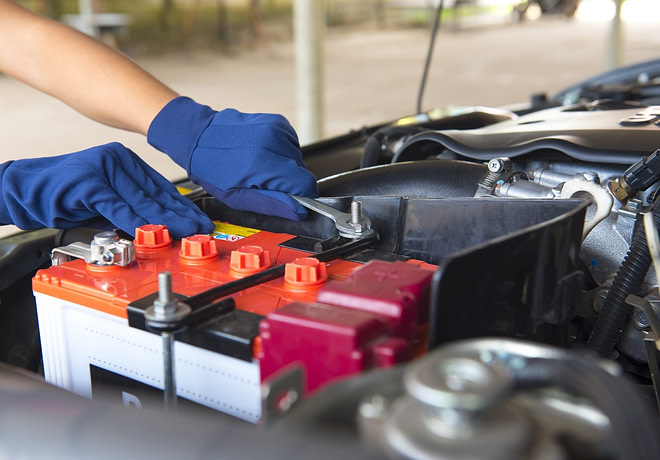The disheartening empty click when you turn the key in the ignition is a sure sign of a dead car battery. It’s no way to start your day – especially if you’re late for work or school. The trouble is, there are many different possible reasons. To sort it out, first, you need to identify the cause.
Car batteries provide power for a lot of different car accessories. Along with turning the engine over, interior and exterior lights, the stereo, windscreen wipers, and more rely on the car battery to work. Just like any other battery, leaving it for a long time makes it go flat. A bit like your smartphone.
Unlike your smartphone, however, you’d need to leave your car parked for two to three months for its perfectly fine battery to drain.
How does a car battery work?
Car batteries for electric cars are different from cars with internal combustion engines (ICEs). When driving an ICE car, the battery receives a charge from the engine. This is done through the car’s alternator. As the engine runs, the drive belt indirectly turns the alternator’s rotor shaft. This shaft has a set of magnets attached which rub against a coil to create AC electricity.
The AC electricity needs to be converted to DC electricity to be used by the car or stored in the battery. This is done by the alternator’s rectifier and regulator. The converted DC electricity is then sent back to the battery for storage or fed to the car’s electrical components if needed. This little generator keeps car batteries topped up and in good working condition.
As mentioned, electric cars are different. These are charged regularly and only when the car brakes, do any energy from the wheels get fed back to the battery. Because driving an EV involves more motion than braking, it’s impossible to generate enough energy to keep the battery alive for long periods.
Despite the difference in the way ICE car batteries and EV batteries are used and powered, many of the reasons for them draining are the same.
Reasons your car battery is draining
The age of your car battery, the draw of power from other electrical components in the car, and a problem with the alternator are the three most common reasons car batteries drain quickly. Figuring out which reason it is can save you from repeating the ‘empty click’ experience.
An old car battery
Batteries don’t last forever. Eventually, it becomes impossible for them to hold a charge and they need to be replaced. This is as true for ICE car batteries as it is for EV batteries.
The battery for a combustion engine vehicle lasts up to five years. Other conditions can impact battery life too – extreme temperatures and frequent short trips – can reduce a car battery’s life. One day the car battery could be working fine and the next it’s just not. If the car battery is four years old or more, it probably needs to be replaced.
Electric vehicle batteries are a little different. Unlike ICE car batteries, they lose capacity over time. This means they take and hold less and less charge as the years go by. One study found that the Nissan Leaf lost 3% of its capacity after the first year.
The steady decline of EV battery life takes anywhere from 10 to 20 years. After that, they need to be removed and replaced professionally. Some manufacturers have EV car battery recycling schemes.
You left something on
It could be the headlights, the radio, or an interior light that was left on. Whatever it was, your ICE car battery powered it through the night until it ran dry. By the next day, there’s not enough charge to get your motor running.
If this is the case, the easiest solution is to get a jump start from a neighbour, breakdown call-out, or friend and leave your car running for a good half hour or more to push power back to the battery.
In the case of an EV, you need to leave the key in the ignition for the secondary electricals to work. Without the key, most EVs will shut off headlights and other electricals after a ten-minute wait. Because of this mechanism, it’s almost impossible to run the EV battery flat by forgetting to turn things off.
Parasitic battery draw
Even when your car isn’t running, the battery powers various functions – the clock, car alarm and interior lights are a few. If the battery is old, too many of these accessories or a fault with one of them can drain your car battery overnight. Make sure everything is switched off when you leave your car at night.
If you’ve had problems with the battery since having a new accessory added, it could be down to poor wiring or faulty accessories. These can continue to draw power from the battery even when they’re switched off. Best to get these and the battery checked out.
Corroded connections
Car batteries – and all other batteries – have positive and negative points. These are known as terminals and in cars, they can become dirty, rusty and corroded. These inhibit the connections and make it difficult for any charge in the battery to be transferred to the engine or other electrical components.
If you notice the car battery terminals are loose, corroded or dirty, you’ll need to disconnect the battery, then clean and tighten them. Then hook it back up to get going again.
Extreme temperatures
You may have noticed that your digital camera loses charge faster on snow holidays or your smartphone hates being left in the sun. That’s because extreme heat and cold are bad for batteries. That goes for your car battery too. Cold weather drains the power from batteries faster and prolonged high temperatures hinder performance too.
This is particularly true for older batteries. If you find your car battery is draining faster over winter or causing you problems on hot summer days, it’s an indication its days are numbered. Whether you drive an EV or an ICE car, consider replacing the battery.
Faulty alternators
Remember the little generator that sends charge from your engine back to your car battery? If that’s not working properly, it will mean your battery doesn’t charge and could even cause you to stall while driving.
The driver’s control panel should have an indicator light that looks like a battery. When this lights up, it means you have a problem with your alternator, battery or both. You’ll need to visit a mechanic or check over the alternator, battery and connections yourself.
Poor battery management
Unlike drivers of ICE cars, EV drivers need to be really careful of how they manage their car battery. An EV battery shouldn’t be allowed to run lower than a 20% charge and occasionally charged to just 80%. This avoids overcharging and prolongs the battery life.
When managed well, EV batteries only lose a small percent of their capacity each year, poor car battery management will cause them to deteriorate much faster.
Whether you drive an ICE car or an EV, proper battery care will keep you happily motoring for longer.









Related articles